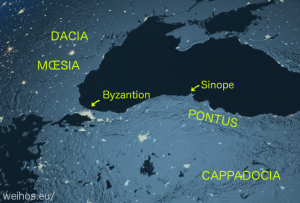We have seen in two previous articles that sometimes the Gothic bible uses one synonym consistently for a number of verses and then switches to using another synonym for a few verses. How about studying synonyms and orthographic variants to see if we can isolate an older textform? I do, and even though I am only halfway through, I dare say it correlates with the text reconstructed for Marcion’s gospel of Luke, to a certain extent.
How can that be?

The map was made from imagery by Leewarrior from Pixabay
Marcion’s home town was Sinope. Wulfila’s parents were probably from Cappadocia. Wulfila was ordained Bishop by Eusebios of Nicomedia who sat at Byzantion. That is one likely location for obtaining Greek language exemplars of biblical books. Perhaps Wulfila acquired Latin language exemplars from his friend Auxentius, bishop of Milan. Marcion interacted a lot with the congregation in Rome, so he would have had access to Vetus Latina manuscripts too. There is a close proximity between Marcion and Wulfila in both time and space, so there are many ways for their respective textual types to wind up being similar.
In this first article of a series, we will look at the Gothic verb for burning. There are two roots:
tandjan
*brannjan
Tandjan, when used without a verbal prefix, translates Greek ἅπτειν ‘kindle, ignite’. — Luke 8:16; 15:8.
Intandjan translates κατακαιειν ‘burn down’. Here, kata- means ‘down’ and kaiein means ‘burn’. — Luke 3:17.
Gatandjan translates καυτηριαζειν ‘sear (with red hot iron)’, a rather special sense. Perhaps it was translated via Latin. — 1 Tim 4:2.
Seeing that this word has very specialized senses depending on which verbal prefix it is used with, I argue it had existed for a long time in the Gothic vocabulary when it was used in the bible translation, and so it is old.
*Brannjan
Inbrannjan translates καιειν ‘burn’. — John 15:6.
From its usage, it appears inbrannjan is pretty much synonymous with intandjan.
Gabrannjan translates καυθησομαι ‘burn’. — 1 Cor 13:3.
It is also used in the Calendar and the commentary Skeireins which have no ancient versions in other languages to compare.
I propose that *brannjan wasn’t available to Wulfila as part of his active vocabulary, so that any occurrence of this word in the Gothic corpus may be attributed to a later redactor. Not much later, for the Silver Bible “Codex Argenteus” was produced around year 500 CE, which is a TAQ.
There happens to be a variant in 1 Corinthians 13:3, where preserved Byzantine manuscriptes have καυθησομαι, but many early manuscripts from Egypt and Italy have καυχαομαι ‘boast, gloat’. So, whereas on the surface it looks like the Gothic version supports the variant here which textual critics call “byzantine” and refer to as byz, the translation made by Wulfila, which could potentially be very Byzantine as he spent a lot of time in Byzantion, might support a different text as otherwise it would have been more likely to use a form of the word tandjan than *brannjan.
To see the other posts of this series, view tag Old Byzantine.
